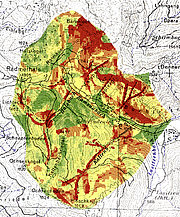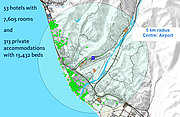S.D.I.M. -
SPATIAL DATA INTEGRATED MASTER PLANNING
What is S.D.I.M.?

S.D.I.M. is master planning based on geographically referenced spatial data. Managing, analyzing and displaying all forms of relevant planning data are conducted in an integrated environment based on a geographic information system (GIS). Geography plays a role in nearly every master planning decision: choosing site locations, targeting market segments, planning transport infrastructure networks, responding to natural hazards or emergencies and redrawing boundaries. S.D.I.M. has the capability to analyze, query, question, interpret and visualize master planning data in the form of maps, globes, reports and charts. It assists in decision-making and problem solving by presenting data in a way that is intuitive and easily understood. Moreover, S.D.I.M. can be integrated into any enterprise information system framework.
Why use S.D.I.M.?
When organizing a major event, designing a resort or undertaking urban planning, master planning requires many major on-site decisions, such as infrastructure types and dimensions and impacts on the environment. Multiple diverse data has to be integrated and analyzed in order to make critical planning decisions. S.D.I.M. can integrate and relate any data with spatial components, regardless of the date source. Ist functionality can create a “virtual geographic world” and run simulations for many different thematic questions and regions. In combination with nongeographic applications and calculation programs, this can lead to significant savings in time and money during a master planning process.
Three aspects of S.D.I.M.
1 | Database
S.D.I.M. is built on a single database that combines project and geographic features (Geodatabase), an information system for spatial master planning.
2 | Mapping
S.D.I.M. visualizes data as intelligent maps and other views displaying features and feature relationships on the earth’s surface. Maps of the underlying geographic information can be created and used as “windows into the database” to support queries, analysis and present master planning information.
3 | Modeling
S.D.I.M. consists of transformation tools that can derive new geographic and project datasets from existing datasets. These geoprocessing functions apply analytical functions and write results into newly derived datasets and the analyses can assess data and make planning recommendations.
Spatial Data Integrated Master Planning
Planning, viewing, controlling and monitoring process based on geographic and project data to be used by multiple stakeholders and responsible entities (Organizing Committees & Infrastructure Delivery Authorities, Investors, Public Planning Authorities) S.D.I.M.’S BENEFIT:
- Common database for all stakeholders (operations, infrastructure, legal, finance, etc)
- Common project management, monitoring and controlling process
- Visualization of project’s progress for all stakeholders
- Basis for strategic decision-making (venues, environment, properties, transport, etc)
- Long-term benefits for the development of a region (management, environment, tourism, public maintenance)
- Transparency of project circumstances (geology, natural risks, local requirements)
- Special tools for security, emergency and healthcare planning
- E -learning for staff, volunteers and other stakeholders
SDIM’s applications
- Operational plans
- Security plans
- Transport models and spectator flow simulations
- Accommodation database
- Landowner agreements and cadastral legal issues
- Resort master plans
- Facility management
- Geographic Data Management (GDM)
- Raw material and labor force procurement (transport & logistics support)
- Urban redevelopment and regeneration
Services
- Geodata capturing and project management
- Data structuring and project buildup
- Web and mobile solutions
- Mapping
- Project Development
- Data Processing



